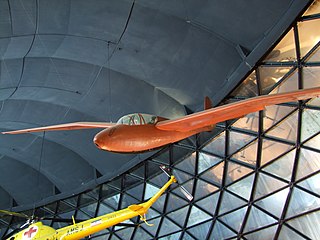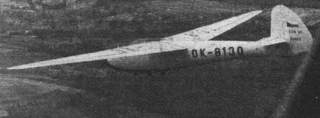
The Oberlerchner Mg 23 is a single-seat, all-wood, high-performance sailplane. It was built and first flown in Austria in 1955, and a total of 26 were built before production ended in 1965.

The Arsenal Air 100 is a French single seat competition sailplane produced in the 1940s. It sold in small numbers but set several records, still holding the world absolute solo glider endurance record of 56 h 15 m.
The Bréguet Br 900 Louisette was a short-span, single-seat competition sailplane built in France in the 1940s. It set some French gliding records but was unsuccessful at the international level. Only six production aircraft were built.

The Ikarus Košava is a two-seat sailplane designed and built in Yugoslavia in the early 1950s. It won the 1954 World Gliding Championships in the two seat category and came second in the same event two years later.

The Cijan-Obad Orao is a competition single seat sailplane designed in Yugoslavia just after World War II, one of the most advanced of its type at the time. It flew in three World Gliding Championships, having greatest success at its first in 1950 when it reached third place.
The CVV1 Pinguino was a single seat, high performance glider designed and built in Italy in the mid-1930s, the first of a series of gliders from the Milan Polytechnic. It did not go into production.
The CVV 3 Arcore was a single seat competition glider designed and built in Italy in the late 1930s, a development of the CVV 1 Pinguino. It participated in several national gliding competitions in the short period before the outbreak of World War II.

The DFS Rhönsperber, otherwise known as the Schweyer Rhönsperber or Jacobs Rhönsperber was a single seat competition glider designed in Germany by Hans Jacobs and first flown in 1935. For several years it was regarded as the best German sailplane and about one hundred were built.

The DFS Reiher was a single seat competition glider designed in Germany by Hans Jacobs and first flown in 1937. The type won the last two German Rhön gliding championships before the start of World War II. Six were factory produced.
The DTGL Sant' Ambrogio was an Italian single seat glider, designed and built by a 19-year-old model aircraft enthusiast, that competed in the 1938 national championships. Four more were constructed from his plans.
The Teichfuss Sparviero was an Italian single seat aerobatic glider, designed by Luigi Teichfuss and flown in 1938.
The Teichfuss Allievo Pavullo was an Italian single seat open frame primary glider, designed by Luigi Teichfuss of Pavullo and first flown in 1940. It was sold in two versions, strut and cable braced. A single two seat variant was also built.

The RRG Fafnir, named after the legendary dragon, was a single seat German high performance glider designed by Alexander Lippisch. It won the Rhön competition in 1931 and made several outstanding flights as well as setting a fashion for gull wings.
The IIL IS-4 was a single seat, high performance sailplane designed by Iosif Șilimon and built in Romania in the late 1950s.
The IFIL-Reghin RG-5 Pescăruș or CIL Reghin RG-5 Pescăruș was a Romanian single seat sailplane built in the 1950s. Twenty six were constructed for gliding clubs.

The Schleicher Ka 3 or Kaiser Ka 3, is a 1950s single seat training glider, mostly sold in kit form.

The Zlín Šohaj series of club gliders began as a post World War II development of the DFS Olympia Meise. A large number were built in the 1940s and '50s.
The Musger Mg 9 was a tandem two seat glider built in Austria in the mid-1930s. It broke both world and national records.

The Rotter Nemere or just Nemere was a Hungarian high performance, single seat sailplane designed and built for the 1936 ISTUS gliding demonstration held in 1936 alongside the Berlin Olympic Games.
The Jancsó-Szokolay M22 was a Hungarian single-seat sailplane first flown in 1937. Twenty were built and the type set several national records. Some remained in service up to about 1953.










